IGP:Digital Publisher. 2013-Q3 Updates
22 August 2013
We are excited to announce a range of new features for IGP:Digital Publisher. These address client feature requests, new planned features and bug fixes. The following updates have been implemented in the 2013-Q3 IGP:Digital Publisher major release.
We are excited to announce a range of new features for IGP:Digital Publisher in the 2013-Q3 release. These address client feature requests, new planned features and bug fixes.
The following updates have been implemented in the 2013-Q3 IGP:Digital Publisher major release:
Major Production Tools
e-Indexer
The eIndexer allows the creation of fully formatted and structured Indexes interactively in real time. The created indexes can be generated for print and e-book formats. The eIndexer can be used incrementally at any time while a document is being authored or edited.
This was developed and improved over three months with significant input, testing and patience by the Sydney University Press editorial team. Thank you for your input and asssistance.
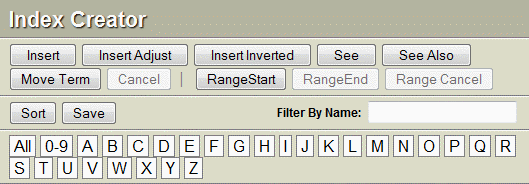
More information on eIndexer ►
SMIL Production
IGP:Digital Publisher now supports a full two pass SMIL file production procss. The SMIL production tools are now available for developing all forms of read-aloud books for accessibility and general reading enjoyment.
Step 1. inserts SMIL IDs into the IGP:FoundationXHTML at the selected highlighting density (paragraph, sentence, phrase or word), generates the SMIL files and audio label files for Audacity. The processor attempts to position the label track markers based on reading duration.
The Audacity label files are then downloaded and checked and adjusted for timing accuracy.
In Step 2 the Audacity label files are uploaded and the audio file timing is exactly syncronized with the fine-tuned file. The files are ready for ePub3 or any other suitable format generation.
All IGP:Digital Publisher generated SMIL files will work online with the AZARDI Interactive Engine because the SMIL XML is XSL parsed to a JSON array and used directly by the AIE Javascript playing engine. This bridge approach allows 2003 XML technology to work effectively with 2013 HTML5/Javascript.
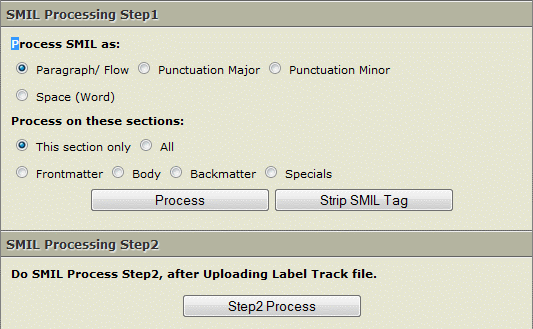
More information on SMIL Production and Processing ►
Try the demonstration full SMIL edition ePub3 of A Christmas Carol here (82MB) ►
TIB - Typography In the Browser
TIB has two major updates.
Productivity Improvement for multi-pass Proof edits. Now text edits appear in the output PDF and Reader interface. A pink highlighting is used to allow an editor to quickly check to see if any proofing edits have made changes to the typesetting.
Edited paragraphs can be individually or globally reviewed and the merge button used to clear the edit highlighting after inspection.
Typography Report Generator. Account specific Typography rules can now be setup and a typographic report generated for each chapter of the book. This considerably speeds up typography and allows quick and easy checking . This is available
under the Templates > Typo Setup. Rules for Section Turns, Page Turns, Paragraph Turns, Line Turns
can be defined. Based on these rules the TIB generates a typography report on the Section PDF. On the
TIB interface a new button "Generate Reports" has been introduced.
It has been called "the future of typography"!
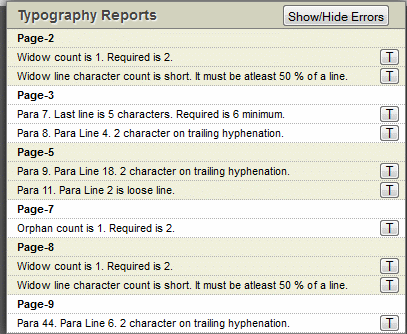
Hair Space in Typography in the Browser (TIB) - The option to insert a hair space 'HS' is now available in the TIB Tracking interface. Click the “HS” button to insert the hair space in the current cursor position.
More information on Typography in the Browser ►
Manuscript and File Importing
IGP:Digital Publisher has a major upgrade on files that can be imported and especially for house-styled word processor manuscripts.
It is now possible to customize the import cross-walk from a publisher's house manuscript styles to IGP:FoundationXHTML without any technical intervention. This is done with a simple cross-walk created in a spreadsheet. It only needs to be done once by the publisher's team or our support team.
In addition old ePubs, generic HTML, FXHTML packages and custom XML such as DocBook and DaisyXHTML can be imported.
There is also an experimental PDF import function for simple novel-level PDFs. Please read the instructions before using this feature.

General Productivity Tools
FXHTML Validation
(QC/QA) The XHTML can now be checked for well formedness. This enables verification of the document tagging patterns. Generally well-formedness errors only arise if there has been carelessness manual cutting and pasting of external content into the Writer interface. A section/line error report is generated if there are any tagging problems that affect the value of the FX or which may cause processing issues.

Renumber page breaks
(QC/QA)This is a new QA tool available in Content Tools. If there have been any page break tagging errors in retro-digitization production this allows them to be instantly brought into conformance. This will only work if the pagebreak-rw tags have been inserted of course.
Print facsimile pagebreak tagging is becoming more important in e-Books. It is both a convenience and accessibility feature especially if the print edition ISBN is available in the metadata.
Note: Pagebreak insertion will be automated for front-list books in the Q4 IGP:Digital Publisher release. This uses the final typeset PDF and processes the pagebreak-rw tags back into the IGP:FoundationXHTML. This means ePub3 and E0 books will be able to be produced with full page navigation without any human effort. This module is currently in testing.

Document Designer update
(Minor Feature) There is now an option to set up a document with no running heads, and outside folios at the foot of the page (verso folio aligned left, recto folio aligned right). We have added a new option "Outside footer folio only" which wasn't available earlier.
eBook Format Tools
ePub3 Specials
Popup generation for Notes, Footnotes and Glossary Terms E-Textbooks in particular benefit from notes and terms being available in page context with their references. IGP:Digital Publisher extends the feature beyond just footnotes (a very "print" concept) and includes Notes and Glossary Terms. This allows publishers to at least consider authoring e-book works for digital only delivery.
- Footnotes. Check this option to generate pop-up for Footnotes. Pop-up for Footnotes will currently work in AZARDI and iBooks and not on any other platform.
- Notes. Creates pop-up references for Notes. This is an AZARDI textbook feature and is not supported by any other Reading system.
- Glossary Term. Check this option to generate pop-up for Glossary terms. This is an AZARDI textbook feature and is not supported by any other Reading system.
Insert epub:type pagebreak. Inserts the epub:type="pagebreak" property into the FX pagebreak-rw tags during ePub3 format generation (if the pagebreak-rw tags have been included).
Note. The FX pagebreak-rw tag is still used in ePub 2 books for Index navigation to the page top.
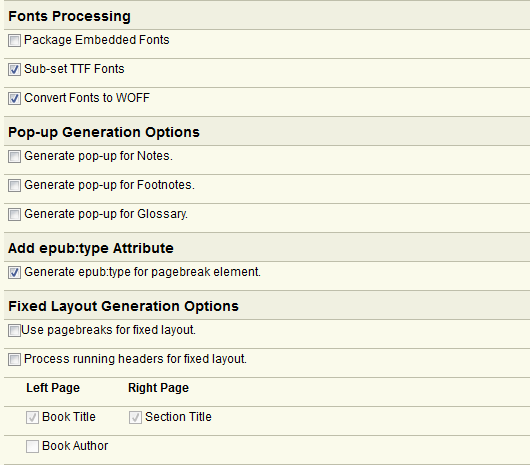
CSS-3 Media Packaging for Kindle
The Kindle packager now combines KF-7 and KF8 CSS into a single package using @media. There is only a single Kindle button on the Formats on Demand interface.
This means one mobi file can be used across all Kindle reading devices. The KF-7 is "dumbed down" for the older eInk products while the KF-8 exploits the wider range of CSS available in the Kindle Fire products and reflects any custom styling carried out for the book.
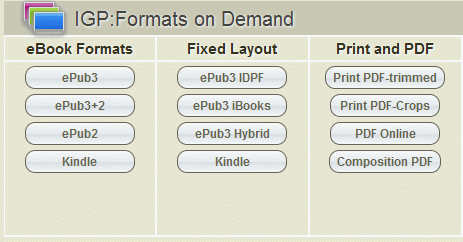
Auto Generated TOC Custom Position
The position of the TOC in an output ePub is defined by the position of the Landmarks page in the production Writer book, or by repositioning it in the DPI re-order interface. For example this allows very large TOCs for fiction works with just a list of Chapter links to be positioned at the end of the book.
Templates and Components
The default DP-Master-2012 template now contains a number of the ALL-IN modules for K-12 education ► publishing. This includes:
- Widgets (See Widget World ►)
- Interactive Arithmetic
- Counting Skills
- Interactive Word Dictionaries.
- Interactive Physics Experiments.
...and much more. ALL-IN is available at no charge to any publisher who has their books produced with IGP:Digital Publisher or licenses IGP:Digital Publisher.
The simple configuration tagging pattern below is configured in IGP:Writer. This gives the editor complete control over the interactive problem construction from simple to complex for all arithmetic problem types:
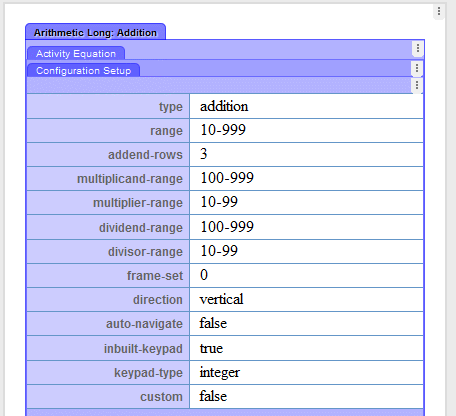
Based on the configuration options this is what you see in IGP:Reader. Instantly interactive. This is the interactive interface for your ePub3, LMS or static site.
Note that this approach allows the use of any language and also locale context. For example this does work with Devanagari digits.
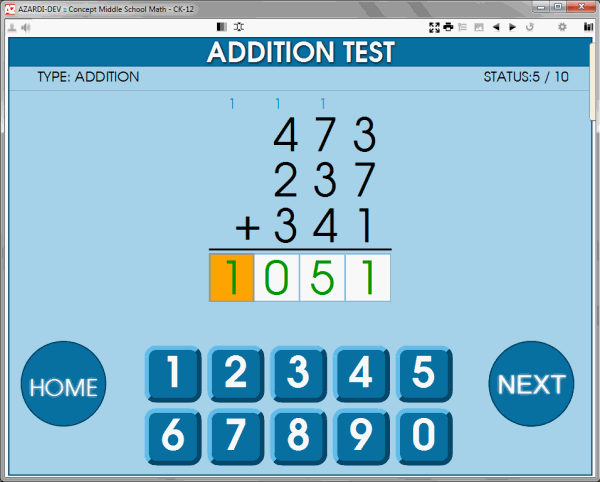
MathML
MathML deserves a special mention. It is now possible to import Maths documents set using from a Word document by using the DaisyXHTML exporter with the Design Science MathDaisy plug in. Design Science Site ► .
The exported XHTML is converted to IGP:FoundationXHTML on import into IGP:Digital Publisher.The result is excellent ready to work MathML in standards compliant HTML5.
IGP:Writer has additional tools added to insert, edit and manipulate MathML ready to create print and e-book formats. MathJax can be automatically packaged into format packages if required.

More information about MathML ►
General Technical Improvements
XML Parser Update. Changed code using XML Parser from lxml to elementTree. XSL files have been upgraded from version 1.0 to 2.0. This provides considerably more XSL processing power with reduced file maintenance overheads.
Bug Fix. Writer Page Saving. Refactored code for duplicate pages issue, when server gets slow. If a save action fails, user gets a red notification on the interface. On section navigation failure the application now shows the error. And the node selected is set to the previous selected node.
Interface Default Language. The default language for the interface can now be set from account setup. The selected language will be the one that opens by default.
Conclusion
IGP:Digital Publisher is maintained as the most complete and powerful digital content production and management system available anywhere. We consider it essential that it lives up to the slogan:
"Digitize Once, Use Forever"
IGP:Digital Publisher is suitable for the production of print books, e-books, LMS content, static site and other specialty and custom packages.
Posted by Richard Pipe
Start a real digital content strategy with
IGP:Digital Publisher
The complete digital publishing content management and production solution.
Available as for Small and Medium publisher:
IGP:Digital Publisher is also available as a full site license purchase.
Contact us for more information...
Use one master XHTML file to instantly create multiple print, e-book and Internet formats.